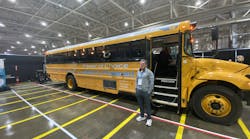Editor’s note: Welcome to So That Happened, our editors’ takes on things going on in the manufacturing world that deserve some extra attention. This will appear regularly in the Member’s Only section of the site.
Electric-School-Bus Economics
Two years ago, an IndustryWeek editor traveled to San Antonio, Texas, for the ribbon cutting of Navistar’s state-of-the-art truck assembly plant, where gas-powered and electric trucks could be assembled on the same line.
Well, the electric trucks built in San Antonio haven’t taken off as quickly as their Glossy Yellow cousins built in Tulsa, Oklahoma—namely, Navistar’s electric school buses.
“We’re selling more electric school buses than we are trucks right now,” said A.J. Palmisano, Navistar’s director of zero emissions charging and infrastructure. “There’s a lot of funding available for the school buses. The [total cost of ownership] on trucks isn’t quite there yet.”
Palmisano and his team were testing a brand-new Navistar school bus on different manufacturers’ charging systems at the CharIN “Testival” in Cleveland. He gamely fielded reporters’ questions on everything from “Does this bus do donuts?” (“Ah, maybe”) to how many school buses exist in the U.S. (480,000).
Navistar’s bus business has “grown a lot,” he explained, “because if you fit a particular demographic, you can basically get a free bus.”
Through the Bipartisan Infrastructure Law, “there's enough government funding that the bus will be free—and the charger, if it's a small enough charger, will also be free. So if you're in a disadvantaged area, rural area, that kind of thing, you can just about get a free bus.”
Summer, when buses are mostly idle, is a prime opportunity for school districts to monetize vehicle-to-grid charging. “This [bus] has a 315-kilowatt-hour battery pack, which is just sitting somewhere all summer long,” said Palmisano. “That is a perfect opportunity to send energy back to the grid, where somebody can buy the energy, cheap, and sell it back a little bit more expensive. Resiliency on the grid, that kind of thing—school buses are natural for that application.”
Eventually, truck sales will go up faster than school buses, he said. “There simply aren’t as many school buses sold, period, in the country.”
Palmisano and his team have brought the electric buses to a number of international events. “You know what’s a lot of fun? We get people from Europe asking, 'Can I go inside the school bus?' Because it's a purely American thing. 'I've seen it on Napoleon Dynamite, Fast Times at Ridgemont High. Can we sit inside this? Everyone take a picture.’”
—Laura Putre
Volvo Cars to Electrify with ABB Production Packages
Automation company ABB will deploy over 1,300 industrial robots and functional packages to bolster sustainability and electrification efforts at Volvo Cars. The collaboration aims to provide a smart and smooth transition to EV production.
“The automotive industry’s historic transformation, driven by increasing consumer demand for electric vehicles and a desire to operate more sustainably, is creating new opportunities as well as challenges for global manufacturers,” said ABB Robotics President Marc Segura. “Through our new, energy-efficient large robot family and OmniCore controllers, we will help to deliver energy savings of up to 20% at sites around the world.”
The project’s functional packages are a ready-to-use combination of hardware, software and services that cover production tasks like spot-welding, riveting, flow drilling and more. The first deployments, expected early this year, will be implemented at Volvo Cars’ Torslanda, Sweden and Daqing, China facilities.
—Anna Smith
Boy, I Got that One Wrong
It’s early January, a time for projecting what to expect for the new year, but I’ll be taking a look back to 2020. Writing for an automotive manufacturing magazine, I boldly predicted that the professional pundits were wrong to assume that auto sales would fall to fewer than 17 million units in the new year.
It seemed obvious. Economists with mathematical models had predicted fewer than 17 million auto sales in 2019 and 2018, and consumer demand for new crossover and SUVs had proven them wrong in both of those years. My logic for predicting a sixth consecutive year of 17+ million new vehicle sales:
- Interest rates were flat with the Fed signaling no increases in 2020 (rates fell sharply… for reasons that weren’t obvious when I made my predictions)
- International trade tensions had subsided. Then-president Donald Trump had stoked fears of a global tariff war in autos in 2018 and 2019, but by early 2020, a new USMCA had replaced NAFTA and no new tariffs were in the works at the time.
- Major automakers weren’t planning on culling any high-volume product lines as they had done in 2018 and 2019.
Not mentioned in those bold predictions? A virus that was spreading through China at the time that was about to upset global trade. During a webinar presented in early 2020, I mentioned COVID-19 in passing as something that might impact Asia but didn’t look all that serious.
Total auto sales in 2020: 14.6 million units.
Things got a little better in 2021, hitting 15.1 million vehicles, but fell to 13.9 million in 2022 as supply chain challenges hampered production.
Year-end-tallies for 2023 aren’t out yet, but Cox Automotive predicts 15.5 million new cars and trucks sold last year, the highest level since 2019, yet still well below my lofty 2020 projections.
A line that I particularly regret from 2020 read, “There are fewer giant question marks hanging over the economy than there have been in years.”
I note all of this as a cautionary tale for the art of prognostication. I had good, logical reasons to expect auto sales to remain elevated in 2020, as did the professional economists who had lower but similarly wrong projections, because none of knew that the world was about to change. So, please take all of the new predictions offered by IndustryWeek and other publications with the same healthy skepticism.
—Robert Schoenberger
Predictions Scorecard: Rodney Brooks Weighs in on Many Things Scientific
Rodney Brooks is at it again, updating predictions he made in 2018 about self-driving cars, robotics, artificial intelligence, machine learning and human space travel. On Jan. 1, Brooks posted his sixth annual update at rodneybrooks.com, and he has promised to review his predictions at the start of each year until 2050, at which point he’ll have reached age 95. “The idea is to hold myself accountable for those predictions. How right or wrong was I?” he muses on his blog post.
If you’re not familiar with Brooks, here’s a little background. The former director of the MIT Artificial Intelligence Laboratory is a founder of iRobot, maker of the Roomba, and Rethink Robotics (think collaborative robots Sawyer and Baxter with their digital eyes). Currently he’s a founder and CTO of Robust.AI, another venture centered around robots on the factory floor. Brooks has written numerous books and a wealth of scientific articles.
If you think all that scientific background translates to a blog full of dry reading, you’d be wrong. For example, in reference to predictions he has made around autonomous vehicles, as well as recent news that Cruise robotaxis relied at times on remote human assistance, Brooks wrote, “We were told by the companies that their vehicles were safer than human driven vehicles, but in fact they routinely needed humans to monitor and to control them. At one level I’m shocked, shocked, I tell you. At another level I am embarrassed that they fooled me. I had thought they were driving with no person monitoring them.”
He continued, “The reason I posted my predictions and talk about them every year was to try to overcome the hype that fools people about how far along technology is.”
IndustryWeek has interviewed Brooks several times over the years, and in 2016 he accepted an IW excellence award for manufacturing technology leadership.
Brooks’ latest prediction package is a lengthy read, but an interesting one if such future-facing topics intrigue you in any way. I’ll close with an update he made regarding “regular service of Hyperloop between two cities.” Not in his lifetime, or “NIML,” Brooks said in 2018. His 2024 update: “Calling this one 26 years early. As of today no-one is still working on this in an operating company.”
—Jill Jusko
A Bounce-Back Year for M&A?
It admittedly doesn’t take much to stand out during the relatively quiet pre-holiday news cycles but we couldn’t help but notice that Dec. 21 was quite the day for manufacturing deal announcements. In the space of a few hours, word came that:
- AAR Corp. plans to buy Triumph Group’s maintenance, repair and overhaul unit for $720 million
- Bearings and industrial motion player Timken Corp. has bought a Dutch maker of sealing products, mainly for water applications, that has about $40 million in annual sales
- Private-equity firm Monomoy Capital Partners has agreed to buy 4,000-employee Waupaca Foundry from Proterial Ltd.
- The materials specialists at Opta Group have acquired Anker Industries, which makes metallurgical additives and recycles aluminum from a plant near Pittsburgh
Is a broader M&A surge in the works after a year in which global deal values were, per Bloomberg, on track to come in below $3 trillion for the first time since 2013? Let’s insert here some needed caveats about many dealmakers wanting to put a bow on transactions before year-end and, more importantly, investment bankers maybe talking their book after a rough year.
But the financial flurry we saw before the holidays also speaks to a key trend that strategy and corporate finance pros at KPMG have been following: Many company leaders and financial sponsors are fine-tuning their portfolios, divesting units considered non-core and buying businesses that help them dive deeper into target markets. Add to those goals the expectation of lower interest rates in 2024 and activity seems to poised to pop.
—Geert De Lombaerde








